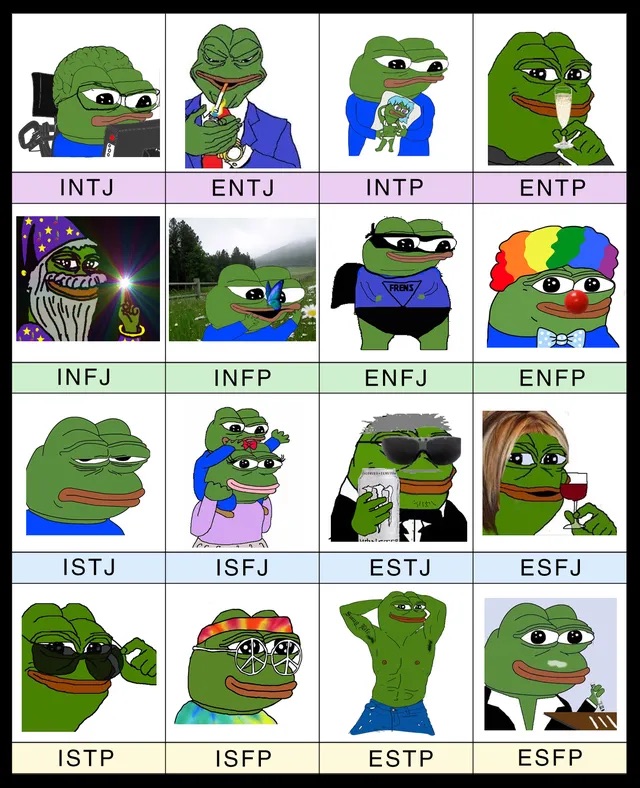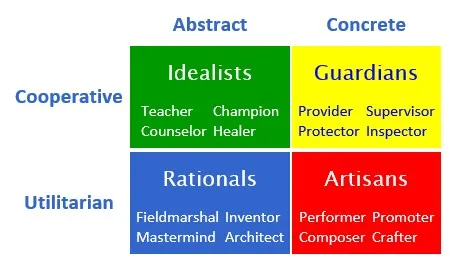There is a system of personality classification called the MBTI – Myers-Briggs Type Indicators. It is similar to the “Big 5” personality test. MBTI assigns four characteristics to a person, each of which can be one of two binary qualities, ending in 16 unique personality types. Briefly, the first letter is how you relate to people, whether you are “I” for introverted (lose energy around people) or “E” for extroverted (gain energy around people).
The second letter is how you relate to the world, whether you are “N” for intuitive (naturally think about abstract concepts and ideas) or “S” for sensing (dealing best with the world around you and your immediate circumstances).
The third letter is how you process your observations about the world, whether you are “T” for thinking (everything is logically assessed, measured, and categorised) or “F” for feeling (the world speaks to you through concepts like justice, beauty, spirituality, and your own feelings).
The fourth and last letter is what you do with your assessments of the world, whether you are “J” for judging (you take information and assessments, weigh their truth or assign quantities, and act on them), or “P” for perceiving (you take information and events as a springboard for more possibilities and are less likely to make firm calls on things). For example, my type is INTJ. You can take tests to find out what your type is, or you can just look at the pepes below and choose which one you resonate with the most. Mine’s pretty accurate at least.
 This system is itself more or less interesting to people depending on their personalities. It drills down further into something called “functions” which assigns a polarity to the middle two letters above and gives greater clarity as to how information is taken and processed. It also zooms out further and derives four categories which each contain four personalities. Studying functions is useful on a personal level, but as this article deals with group-level dynamics, we’ll be looking at how each of the four categories approaches culture and sociopolitical movements. A psychologist named David Keirsey labelled the four categories as Guardians, Artisans, Rationalists, and Idealists. In Keirsey’s system, the first binary slice is between Sensors (Guardians and Artisans) and Intuitives (Rationals and Idealists). Each then divides in two again based on different criteria. We’ll now look at each quadrant and their relations to dissident political movements.
This system is itself more or less interesting to people depending on their personalities. It drills down further into something called “functions” which assigns a polarity to the middle two letters above and gives greater clarity as to how information is taken and processed. It also zooms out further and derives four categories which each contain four personalities. Studying functions is useful on a personal level, but as this article deals with group-level dynamics, we’ll be looking at how each of the four categories approaches culture and sociopolitical movements. A psychologist named David Keirsey labelled the four categories as Guardians, Artisans, Rationalists, and Idealists. In Keirsey’s system, the first binary slice is between Sensors (Guardians and Artisans) and Intuitives (Rationals and Idealists). Each then divides in two again based on different criteria. We’ll now look at each quadrant and their relations to dissident political movements.
 The first group that must be dealt with is the most prolific in any dissident group – the Rationals. These are types who have the N and the T – they are intuitive thinkers, and a very small percentage of the population, perhaps at most 10%. Virtually every dissident movement or political theory comes from these types, and as they are intuitive and therefore highly sensitive to logical inconsistencies, they are littered through dissident and alternative groups of all stripes. Although they value truth, principle, and pragmatism, they may still arrive at positions which can seem rigid and stolid, such as traditionalism, albeit only through rigorous investigation and research – they are not wont to do things the same way simply because that’s how it’s always been. As they are not overly moralising, they are drawn to anonymous and pseudonymous types of communication where anything can be thought or said. In the past, Rational types were often persecuted for any thought or action deemed antisocial, and so were often kept to their own in places like universities. Sometimes, when the time was right, great strategists and leaders came from this group, such as Julius Caesar, Napoleon, and Alexander the Great. Since today we can’t have exclusive cultural spaces, and the qualities of great men are often too extreme, Rationals are drawn to exclusive online spaces which are mostly self-selecting by the tone of conversation – if you can’t handle the heat, you’ll get out of the kitchen pretty quickly, and as such it is a strongly male archetype. For Rationals, any thought can be considered, put into its own silo of reality, and operated until its strengths and weaknesses are shown. When it comes to sociopolitical theories and movements, it’s a Rational’s game and everyone else is just along for the ride. These are the people you argue facts and logic with.
The first group that must be dealt with is the most prolific in any dissident group – the Rationals. These are types who have the N and the T – they are intuitive thinkers, and a very small percentage of the population, perhaps at most 10%. Virtually every dissident movement or political theory comes from these types, and as they are intuitive and therefore highly sensitive to logical inconsistencies, they are littered through dissident and alternative groups of all stripes. Although they value truth, principle, and pragmatism, they may still arrive at positions which can seem rigid and stolid, such as traditionalism, albeit only through rigorous investigation and research – they are not wont to do things the same way simply because that’s how it’s always been. As they are not overly moralising, they are drawn to anonymous and pseudonymous types of communication where anything can be thought or said. In the past, Rational types were often persecuted for any thought or action deemed antisocial, and so were often kept to their own in places like universities. Sometimes, when the time was right, great strategists and leaders came from this group, such as Julius Caesar, Napoleon, and Alexander the Great. Since today we can’t have exclusive cultural spaces, and the qualities of great men are often too extreme, Rationals are drawn to exclusive online spaces which are mostly self-selecting by the tone of conversation – if you can’t handle the heat, you’ll get out of the kitchen pretty quickly, and as such it is a strongly male archetype. For Rationals, any thought can be considered, put into its own silo of reality, and operated until its strengths and weaknesses are shown. When it comes to sociopolitical theories and movements, it’s a Rational’s game and everyone else is just along for the ride. These are the people you argue facts and logic with.
The second group to deal with is the Idealists, those with N and F letters – intuitive feelings people. Percentagewise they are slightly more numerous than Rationals, perhaps 15% of the population. In many ways they are the Rationals’ achilles heel. Idealists take the world and make it all into a war of emotions. They are the sort to see an injustice and try to do something about it – the sort to organise a protest, not imagining some specific outcome like other types might, but simply because that’s the loudest way to express their overwhelming sense of morality. You guessed it, Idealists are basically the special snowflake type. Indeed, before snowflake became an internet insult it was often used to describe these types in a good-natured, slightly tongue-in-cheek manner. The most active SJWs will often be Idealists, but given the left-lean of media and academia, many younger people of all types will find themselves in SJW circles simply by cultural osmosis. Although it is a strongly feminine archetype, there are male Idealists who will either champion causes until they’re marginalised for being male, or will grow up feeling displaced or misunderstood and align with dissident right politics often because they feel the principles of truth, beauty, and goodness have been violated. Idealists often fall in with artistic types for brief friendships, and ironically will almost inevitably fall in love with Rationals who give their world a sense of meaning and order. These are the people you sway with arguments on how things are deeply affecting people.
We have dealt with the N types, the intuitives who are comfortable with abstract ideas. Now we are looking at S types, sensors who really deal with what’s in front of them. Where intuitives are divided by the way they process abstract information, through thinking or feeling, sensor types are divided by how they approach the world given the information they are fed. This means they are either categorised by J for judging or P for perceiving. Their approach to dissident politics is interesting simply by what it indicates in terms of where the world is moving and what the status quo is shifting towards.
The third group is Artisans, they have S for sensing and P for perceiving. They look at what’s in front of them and see immediate possibilities. They might be around 20% of the population. For the most part, they want to be left alone to do their thing, and will only become involved in political things if it’s somehow cramping their style. Joe Rogan and Donald Trump are examples of this. The popularity of such magnetic personalities and their devil-may-care sense of political incorrectness shows that most people will happily accept sometimes offensive pronouncements so long as they make practical sense. This is good news for dissidents and a good thing to keep in mind when framing views. More than any other type, Artisans will be the ones to tell you whether something is too complicated or dumb, or if it makes sense and explains everything. That doesn’t mean the thing is right or wrong, but it’s a good bellwether for how communicable your ideas are. Artisans like to make a splash and be unique, even the more introverted types are happy being the centre of attention. This means they will often approach ideology like fashion and simply use it as a means to get something they want. To sell to these people, you need to look effortless and cool.
 The final group is the largest. Guardians, Sensing Judgers, are the majority of the population, most often 40-60% of the people in society. Some guides will call them traditional, but the best word to describe them is conventional. If they’ve encountered an idea before, then it’s okay by them. But if the idea is a bit radical, they aren’t quite sure about it and won’t really engage. They like things to work, and they don’t really like being the one to stand out as different. So, for example, how would you tell Guardians that we need to bring back industry to Australia? You would NOT say something about IQ and conscientiousness being higher in Western populations compared to others, which leads to this that and the other approaches to time preference and industriousness and so on, which makes the goods more valuable and higher quality and therefore – you see where I’m going. It’d work on an intuitive N type but you’d lose all the S types, including Guardians, with that kind of pitch. You would instead talk about how young people need to learn good hard graft, and people need products that aren’t going to break after 18 months. So how do you know if your message is sticking with this huge cohort?
The final group is the largest. Guardians, Sensing Judgers, are the majority of the population, most often 40-60% of the people in society. Some guides will call them traditional, but the best word to describe them is conventional. If they’ve encountered an idea before, then it’s okay by them. But if the idea is a bit radical, they aren’t quite sure about it and won’t really engage. They like things to work, and they don’t really like being the one to stand out as different. So, for example, how would you tell Guardians that we need to bring back industry to Australia? You would NOT say something about IQ and conscientiousness being higher in Western populations compared to others, which leads to this that and the other approaches to time preference and industriousness and so on, which makes the goods more valuable and higher quality and therefore – you see where I’m going. It’d work on an intuitive N type but you’d lose all the S types, including Guardians, with that kind of pitch. You would instead talk about how young people need to learn good hard graft, and people need products that aren’t going to break after 18 months. So how do you know if your message is sticking with this huge cohort?
A good way of telling whether your movement is becoming popular is if it becomes filled with Guardian types, and a good way of finding out if this is so is by constantly throwing new ideas and heretical information at them. If none of it sticks, you’ve probably got a lot of SJ types. This is a good thing for reasons I’ll explain below. Take Traditionalism for example. Traditionalism as a school of thought has many ideological, scientific, and philosophical reasons behind it and is often dealt with abstractly by Rationals or Idealists (Artisans won’t engage as they prefer the loud edgy things), whereas Guardians hear about traditionalism and think it’s their ticket to a good life that makes sense. You can tell that political correctness has gone way too far because it has thrown too many new ideas into society, and these ideas have started to affect the things that Guardians do, like watching the news and movies, going to the football, seeing friends and family, working hard, and expressing the sorts of views that were around when they grew up. You might be thinking that everyone does these things, but for Guardians that’s everything, there’s no secret life of dissidence or activism. When relating ideological things to Guardians, you have a limited window of time with which to communicate – by this I mean you have to tell them how things were done in the days of someone they personally knew, like their parents or grandparents. You can appeal to something cultural that they engage in (appeals to the days of the ANZACs or convicts would be effective), but you cannot give them novel, abstract ideas or they’ll try to relate them to something that already exists, and if they can’t do that they’ll ignore them. But if it sticks, that means most of society is ready to hear what you have to say.
If you’re a dissident, the people typified by those above (Joe Rogan, ESTP, and Jocko Willink, ESTJ) are who you really need to pay attention to. In all likelihood you probably spend a lot of time arguing with other people who are Rationals or Idealists, at most 25% of the population. While this has its place, it’s a much better tell of which way the wind is blowing to look at what the vast majority of people are choosing to consume, and this means studying the Guardian type. Guardians won’t always tell you what they’re actually thinking, so you have to look at metrics like popularity to figure it out. What are more people listening to, Joe Rogan or some generic SJW dribble? Is Jordan Peterson’s book selling out faster than a feminist history of toothpaste? I went into a bookstore within a few days of 12 Rules for Life coming out, and amongst the legions of left wing pulp it was the one book which had sold so many that the store had run out and had backorders. What Jordan Peterson (INTJ) and Joe Rogan (ESTP) are telling people is what they want to hear, that which in their heart they feel is right – “I haven’t oppressed anyone, I’m not at fault, but also there’s just something not right about all this diversity stuff, this climate change stuff doesn’t make a lot of sense to me.” Guardians have a very solid sense of normality and can weather almost any storm.
Know your audience, know your communities, know their tendencies and their limits, and learn how best to pitch the truth towards them.











